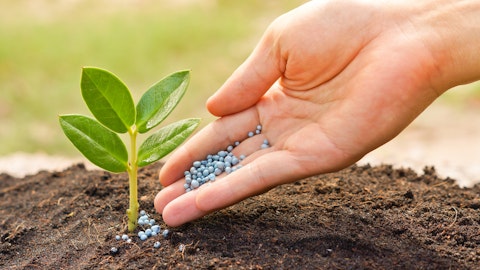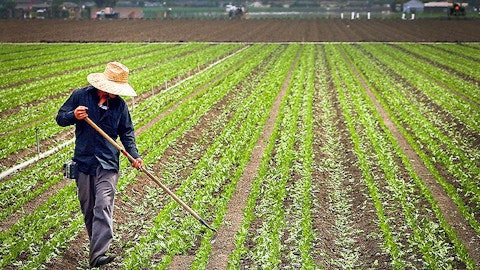The Andersons, Inc. (NASDAQ:ANDE) Q3 2023 Earnings Call Transcript November 8, 2023
Operator: Good morning, ladies and gentlemen, and welcome to The Andersons’ 2023 Third Quarter Earnings Conference Call. My name is Joe, and I will be your coordinator for today. At this time all participants are in listen-only mode. [Operator Instructions] Later we will facilitate a question-and-answer session. [Operator Instructions] As a reminder, this conference is being recorded for replay purposes. I will now hand the presentation to your host for today, Mr. Mike Hoelter, Vice President, Corporate Controller and Investor Relations. Please proceed.
Mike Hoelter: Thanks, Joe. Good morning, everyone, and thank you for joining us for The Andersons’ third quarter earnings call. We have provided a slide presentation that will enhance today’s discussion. If you are viewing this presentation from our webcast, the slides and commentary will be in sync. This webcast is being recorded, and the recording and the supporting slides will be made available on the Investors page of our website at andersonsinc.com shortly. Please direct your attention to the disclosure statement on Slide 2, as well as the disclaimers in the press release related to forward-looking statements. Certain information discussed today constitutes forward-looking statements that reflect the company’s current views with respect to future events, financial performance and industry conditions.
These forward-looking statements are subject to various risks and uncertainties. Actual results could differ materially as a result of many factors, which are described in the company’s reports on file with the SEC. We encourage you to review these factors. This presentation and today’s prepared remarks contain non-GAAP financial measures. Reconciliations of the GAAP to non-GAAP measures are included within the appendix of this presentation. On the call with me today are Pat Bowe, President and Chief Executive Officer; and Brian Valentine, Executive Vice President and Chief Financial Officer. After our prepared remarks, we will be happy to take your questions. I will now turn the call over to Pat.
Pat Bowe: Thank you, Mike, and good morning, everyone. Thank you for joining our call this morning. Third quarter results were solid for the company compared against last year’s best ever third quarter. Our Renewables segment had a record third quarter and was significantly ahead of last year. Trade results were down against last year’s best ever Trade Q3 and included some atypical charges. Nutrient and Industrial results in this seasonally quiet quarter were improved from 2022. Trade results for the quarter include improved results in our North American assets and in the recent investments and acquisitions in premium food and pet food ingredients. Our merchandising results were solid in the quarter, but were negatively impacted by a currency-related loss in Egypt.
With regard to this loss, our international business strategy includes the supply of grain to dense population growth regions in Africa and the Middle East. We enable this through repeatable trade flows with long-term customers. Within our merchandising portfolio, results in our Middle East, North African business this quarter were impacted by limited U.S. dollar currency liquidity in Egypt. As a practice, we sell in U.S. dollars. This loss resulted from an unfortunate and unique situation where we accepted a lower exchange rate from key customers for product already delivered. Given our customers’ limited ability to access U.S. dollars, this was an issue isolated to Egypt, and our other Swiss merchandising business showed an improvement for the quarter.
Operating results from the Renewables business were outstanding with the combination of strong crush margins and efficient operations. Our ethanol production facilities continue to run well with improved ethanol yields and lower plant operating costs. We continue to benefit from good merchandising, particularly Renewable diesel feedstocks where we increased sales volume and further diversified our product portfolio. Our Nutrient and Industrial results in this seasonally low quarter reflect improved margins in our ag supply chain and manufactured products. Brian will now cover some key financial data. And after that, I’ll be back to discuss our outlook for the remainder of 2023. Brian?
Brian Valentine: Thanks, Pat. And good morning, everyone. We are now turning to our third quarter results on Slide Number 5. In the third quarter of 2023, the company reported net income from continuing operations attributable to The Andersons of $10 million or $0.28 per diluted share and adjusted net income of $5 million or $0.13 per diluted share. This compares to net income of $17 million or $0.50 per diluted share in the third quarter of 2022. Overall, gross profit of $158 million for the quarter was just below the $164 million in 2022, with Renewables and Nutrient and Industrial showing increases offset by a year-over-year decline in Trade. For the year-to-date period, gross profit of $528 million increased from $514 million in 2022.
Adjusted EBITDA for the third quarter of 2023 was $70 million compared to $83 million in the third quarter of 2022. Trailing 12 months adjusted EBITDA totaled $374 million. Our effective tax rate varies each quarter based primarily on the amount of income or loss attributable to noncontrolling interests. We recorded taxes for the quarter at a 21% effective rate. We expect a full year adjusted effective tax rate between 21% and 24%. Next, we’ll move to Slide 6 to discuss cash, liquidity and debt. We generated cash flows from operations before changes in working capital of approximately $50 million in the third quarter of both 2023 and 2022. Commodity prices have moderated since the highs of last year, resulting in a sharp decline in our short-term borrowings from over $650 million at the end of the third quarter of 2022, to $14 million in 2023.
Our teams continue to actively monitor working capital levels to ensure appropriate customer service, while balancing interest rate exposure. Next, we’ll take a look at capital spending and long-term debt on Slide Number 7. We continue to take a disciplined approach to capital spending which we expect will be between $125 million and $150 million for the year, about half of which is typically related to maintenance capital. Through September, we have invested about $109 million. Included in this spending are several growth projects, expanding capacity in our premium food, Renewables and Nutrient and Industrial businesses. In addition to the capital investments, we closed on the acquisition of ACG International early in the third quarter, a growth opportunity for us in the pet food ingredient supply chain.
We are evaluating several growth projects in our pipeline, including additional M&A opportunities and projects to lower the carbon intensity of our ethanol production. Our long-term debt to EBITDA currently is about 1.6x, which is well below our stated target of less than 2.5x. We have a balance sheet with significant capacity to support growth investments that meet our strategic and financial criteria. Now we’ll move on to a review of each of our businesses, beginning with Trade on Slide 8. Trade reported pretax income of $8 million and adjusted pretax income of $5 million compared to $41 million in the same period of 2022. We had mixed operating results in our Trade business portfolio when compared to our record 2022 third quarter. In the North American assets, we had improved third quarter results, which included additional wheat space income.

Investments in growth projects, including acquisitions and additional food corn capacity were accretive to our premium food and pet food ingredient businesses. This was mostly offset by a decline in our UK-based organics business, which had record performance in 2022. Aggregate results of our merchandising businesses were down from the third quarter of 2022 and a backdrop of a less dynamic U.S. grain market, although several product lines had improved performance. As Pat mentioned earlier, in the Middle East, North Africa business, we sell in U.S. dollars. However, given the limited U.S. dollar currency liquidity our customers in Egypt have experienced, we elected to accelerate the monetization of certain Egyptian receivables at lower exchange rates.
This decision during the quarter also led to a revaluation of the remaining Egyptian receivables. In total, this resulted in a precheck charge of $19 million or $0.43 per share recognized in the third quarter. Trade’s adjusted EBITDA for the quarter was $21 million, compared to $60 million for the third quarter of 2022. Year-to-date, Trade adjusted EBITDA is $92 million compared to $128 million in 2022. Moving to Slide 9. Renewables had a best ever third quarter generating pre-tax income attributable to the company of $26 million compared to $8 million in the third quarter of 2022. Our current quarter earnings were outstanding due to strong ethanol crush margins, combined with efficient operations at our four production facilities, which drove improved ethanol yields.
Operating costs decreased slightly year-over-year. Merchandising results for renewable diesel feedstocks, feed ingredients, and third-party ethanol trading improved nearly $5 million when compared with 2022. Renewables had EBITDA of $60 million in the third quarter, compared to $34 million in the third quarter of last year. Year-to-date, adjusted EBITDA of $157 million is $13 million ahead of $144 million last year. Turning to Slide 10. The Nutrient and Industrial business reported a pre-tax loss of $8 million compared to a loss of $12 million in 2022. Overall fertilizer margins increased in this seasonally slow quarter. While volumes increased in our ag supply chain business, volumes in Specialty Liquids were impacted by a month long rail disruption at one facility and manufactured products were lower on continued slow consumer demand.
Inventory adjustments that were taken in the third quarter of 2022 did not repeat. Nutrient and Industrial had positive EBITDA for the quarter compared to an EBITDA loss of $3 million in the third quarter of 2022. And with that, I’ll turn things back over to Pat for some comments about our outlook for the remainder of the year.
Pat Bowe: Thanks, Brian. We remain very positive about our 2023 EBITDA outlook and expect to meet or exceed the previously communicated $350 million to $375 million range. U.S. agriculture production remains high with a move to carry markets off of strong harvest volumes, which is beneficial from our grain asset footprint. Farm income is projected to decline from lower commodity prices but should remain above the long-term average. At these levels, we believe farmers should still be incented to invest in crop inputs. With our broad portfolio of ag products, we remain positioned to perform well into 2024. Our trade business outlook remains positive. Corn harvest is ongoing, although a bit delayed in our eastern asset locations as it has been slower to dry down in the fields.
As of this call, soybean harvest is nearly complete nationwide, and the significant soft red wheat harvest this summer is already providing good space income, especially with the first VSR tick starting in September. And wheat income opportunities should continue to expand into 2024. The wet corn harvest in the east should lead to stronger drying income at our grain assets. This delay could move some of our planned fourth quarter elevation income into early 2024, but overall, we are very pleased with the size and quality of the crop in our draw areas. With our balanced portfolio of merchandising and grain assets, we’re able to optimize both volatility and crop dislocation, as well as a potential shift with larger production and carry markets.
We’re projecting a solid finish to the year in trade, although not quite as high as last year’s fourth quarter earnings. In our Renewables segment, ethanol crushed margins have remained very strong with good industry fundamentals. We believe that our Eastern ethanol plants are favorably located with expected lower corn costs post harvest. We remain focused on improving and maintaining our four production facilities for optimal efficiency and are making investments to increase our fermentation capacity. Production continues at a high level and we currently expect to exceed last year’s fourth quarter earnings on a combination of strong plant performance and good merchandising. In addition, our renewable diesel feedstock merchandising business continues to grow and show bottom line improvements.
Our renewables business is important to achieving our growth strategy targets and we are actively pursuing opportunities that will further expand our renewable diesel feedstock business and lower the carbon intensity of our ethanol production with potential benefits from the Inflation Reduction Act. The outlook for this business remains strong heading into 2024. The Nutrient and Industrial business outlook also remains positive. While 2023 net farm income is forecasted to decline from last year’s record high, it remains above the historical average. And corn producers should continue to value specialty products, which maximize yield. As always, the timing of harvest and market conditions, as well as market price and carrying costs will influence our fourth quarter demand.
We currently project an improvement over last year’s fourth quarter earnings. So in summary, as we mentioned earlier, we expect to meet or exceed the previously communicated 2023 range of $350 million to $375 million in adjusted EBITDA. I’m very proud of our team’s hard work and I’m confident in our ability to execute against our strategy, and I’m optimistic about the year ahead. We remain committed to our 2025 EBITDA target of $475 million to be achieved through internal growth and acquisitions. And we remain disciplined in our evaluation of growth opportunities. We’re pleased with the progress on our long-term strategy and will continue to make decisions that benefit customers and maximize shareholder value. And with that, I’ll be turning it over to Joe, our operator, to take your questions.
Operator: Thank you. [Operator Instructions] At this time, we will take our first question, which will come from Ben Bienvenu with Stephens. Please go ahead.
See also Top 20 Drug Companies in the US by Revenue and Top 11 Extreme Value Stocks To Buy.
Q&A Session
Follow Andersons Inc. (NASDAQ:ANDE)
Follow Andersons Inc. (NASDAQ:ANDE)
Ben Bienvenu: Hey, thanks. Good morning.
Pat Bowe: Good morning, Ben.
Ben Bienvenu: Pat, I want to pick up where you left off with respect to the 2025 EBITDA goal. You’re talking about $350 million to $375 million of EBITDA this year. Can you help roughly bridge us from here to the $475 million in 2025? And how much of that is growth CapEx? How much of it is M&A? And maybe to the extent you can timing of the ramp?
Pat Bowe: Yes, terrific. That’s a very good question. Things are playing out from an ag fundamental standpoint very well, especially leading by our renewables business. But the good crop and the outlook for storage income and other basic fundamentals are very solid going into 2024. Our plans for growth include, I’d say, half would be base investments in our core businesses for growth, and half of that being M&A. We’ve been very prudent up to this point about investments and not wanting to overpay for any particular one asset. And I think the higher interest rates may play out to be a benefit to being able to buy something at a more reasonable price range. So we have some projects we’re working on that could help us move forward to achieve that goal. So we’re staying very committed to achieving that target for the long range of 2025. So we feel good about that.
Ben Bienvenu: Okay. Fair enough.
Pat Bowe: My emphasize, half through core and half through M&A.
Ben Bienvenu: Great. Great. Could you compare contrast for us fourth quarter of this year to fourth quarter of last year? And what are the potential risks or opportunities across each of your business lines as we think about monitoring kind of getting to the $350 million to $375 million range at the low end and the top end?
Pat Bowe: Sure. I’ll get started then Brian can chime in. I think the key point, I think was different than last year, the first one’s got to be stronger ethanol fundamentals. So I think the thing that been around this ethanol business for over 30 years, you have to look at a lot of things that impact ethanol, and it’s not just one item, right? So obviously, look at corn basis and our plants and a good corn crop that we’re bringing in right now. Also, you have just lower natural gas costs. We continue to have high income from corn oil and DDGs. We have a steady, consistent demand both domestically and abroad. We still on a relative oxidate level are inexpensive for ethanol, and driving demand has picked up, especially non-commuter related, vacation demand, et cetera, and the outlook remains solid.
So we have good base fundamentals for ethanol that would have been stronger than one year ago. We’ve put a lot of that in the bank already, but fourth quarter looks very good. Same is true for fertilizer. We’ve had a very solid year in fertilizer. A lot of the fourth quarter timing relates to when the harvest comes off and the farmer’s ability to apply fertilizer but we’ve had really good shipments here recently. So we feel solid about how our fertilizer business looks. And overall, our grain fundamentals, we said we have wheat income from storage that we didn’t have a year ago that’s better. Volatility has been a little bit quieter than a year ago. So I think you’ve heard in the marketplace people maybe not quite as extremely bullish as we were a year ago because exports are softer out of the U.S., but domestic trade is still very good and there’s arbitrage opportunities.
We had a very good harvest in Louisiana. That’s behind us now. So fundamentals for grain are very solid. So in general, we have a good backdrop to finish the year. Brian, did you want to add anything to that?
Brian Valentine: Yes. I think that summarized it well. I mean, if I went high level, I would say we expect compared to last year’s fourth quarter, improvements overall in the Renewables segment, some improvement – some modest improvement in our Nutrient and Industrial segment still a strong quarter from Trade, but maybe not quite as strong as last year’s fourth quarter, but we would expect it to be the strongest quarter of the year on a sequential basis and for all the factors that Pat mentioned.
Ben Bienvenu: Okay. Great. Thanks so much.
Operator: And our next question will come from Brian Wright with ROTH MKM. Please go ahead.
Brian Wright: Thanks. Well, I’ve got two questions. And one of them is just to start off with, you talked about investments to increase fermentation capacity, and I just wanted to understand a little more of the detail behind that, what you’re willing to share?
Pat Bowe: Yes. So I think the thing is we look at is efficiency in our facilities. And we’re able to add steep or fermentation capacity, which helps with the put through of the facilities, and also impacts your yields, so both corn oil yields and overall ethanol yields. We’ve had these projects in the work for some times at two facilities. These aren’t overnight additions. So we’ve been making these investments over time. And I think what our ideas are with the Inflation Reduction Act incentives, we’re interested in carbon sequestration potential. We’re active in a project to look at that in one of our facilities right now. And that in combination with making the plants as efficient from an energy standpoint as possible, is really what helps us when it comes to just operating costs, but also for CI score reduction.
So our simple fundamental strategy is the larger scale, high efficient plants with low CI scores will be winners. So we’re taking active progressive steps to continue to invest our plants to do that. So it’s not one big step change, but continued investments to hit that goal.
Brian Wright: Okay, great. That’s helpful. Thank you. And then can we just talk a little bit about like how to think about the currency impact? And how we’re comfortable that dynamic is contained to the third quarter, and just can you help us with that?
Brian Valentine: Yes. Thanks, Brian. That’s a fair question. I’ll start out and then maybe Pat can add some color. So I mean first and foremost, I think it goes without saying we’re disappointed in the currency loss that we took in this quarter. And we’ve already taken steps to ensure it doesn’t happen again in the future. This one really was the result of some highly unusual events, and it’s isolated really to a few deliveries within Egypt. And so it’s not applicable to the rest of the Egyptian business, let alone the remaining international footprint. As we mentioned, we made the decision during the quarter to accelerate the conversion of certain receivables in Egypt at lower exchange rates. This led to a revaluation of our remaining Egyptian receivables.


